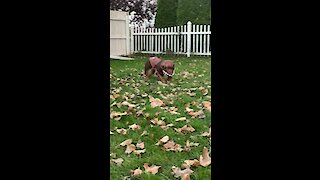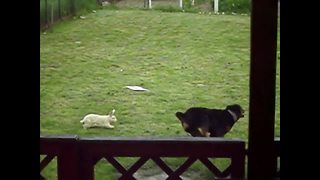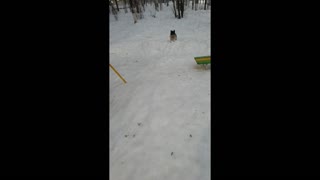Dothis dog pretending like a cool one.
Any pet owner has, from time to time, been charmed and entertained by their furry critters. And that's a good thing! But the empirical question of whether or not animals in general (and dogs in particular) can engage in pretend play was particularly interesting to me. More precisely, does Happy understand that the toy frog isn't really a frog, but instead is an object that represents a category of agents (frogs) - and then, is she pretending that the toy really is a frog, even though she knows it isn't?
Pretend Play in Human Children
Young children do this with ease. They know that a banana isn't a telephone, for example, but since bananas share some common characteristics with telephones, they can pretend that one is the other. In other words, in addition to the primary mental representation of the true identity of the object (banana), they also represent the object's pretend identity (telephone). At what age are humans able to engage in this sort of play?
Young infants try to grasp the objects in pictures, but by nineteen months, their grasping is replaced by pointing - this suggests that by that age, human infants understand that a picture is a representation of something, rather than the thing itself. However, another study found that three year-olds, but not four year-olds, believed that a balloon represented on a TV screen would fly to the ceiling of a room if the top of the TV was removed. So, children between the ages of 18 months and three years might be able to pretend, but they seem to be limited in their ability to fully understand the concept of pretending. Many developmental psychologists would argue that the child need not have the meta-awareness of pretending in order to pretend in the first place; they don't need to know that they are pretending.
Can Animals Pretend?
ADVERTISEMENT
Empirically investigating pretend play is exceptionally hard, because pretend play is by its nature spontaneous. It's only through direct observation and case studies that we have any evidence for pretend play in animals at all - and so far, only really in apes. Even still, the scant evidence that exists for pretend play in non-human apes is fairly consistent.
In 1993, primatologists Jensvold and Fouts analyzed fifteen hours of video footage of five chimpanzees, specifically looking for instances of "imaginary play." These particular chimpanzees (including the famous Washoe - pictured left) had been trained in the use of American Sign Language, which must have helped the researchers in understanding their actions. In the fifteen hours of footage, six instances of imaginary play were documented. Several of them were actions in which the chimps gave living characteristics to an inanimate objects. For example, the chimpanzee Dar signed "tickle" to a stuffed bear. Similarly, Washoe used a natural action called a "hit away," which is usually used with other chimpanzees. The researchers note that "when Washoe made the gesture she had a play face which also indicated the playfulness and nonliteral nature of her actions." The rest of the instances of pretend play in these chimps featured substitution, in which one object was treated as if it was something different. For example, Washoe treated as brush as if it was a book. This was confirmed by the fact that "Washoe often had been observed placing a book under her arm and holding it there which was the same action she used with the brush. Thus her actions and her signing of "book" afterwards were indicative of her substitution." And Mosha treated a purse as if it was a shoe, including signing the word "shoe."
Another researcher described a chimpanzee using a shell first as a cigarette, then as an earring. Jensvold and Fouts recount Hayes's 1952 description of the actions of a home-reared chimpanzee named Viki:
-
 0:11
0:11
adorepankaj
1 year agoSo Funny 😀😀 Acting By Dog 🐶🐕
2 -
 0:43
0:43
ZhemJZ
7 years ago $0.09 earnedToddler pretends to be a dog
2.5K -
 0:09
0:09
covildosvideos
2 years ago $0.02 earneddog imitating the owner
18 -
 0:21
0:21
Bruno the Pitbull videos
3 years agoFoolish dog likes to show off his silly smile
47 -
 1:26
1:26
TotalBullies
5 years ago $5.53 earnedBulldog totally confused in new dinosaur costume
5.67K -
 1:23
1:23
Gin_todd07
6 years ago $1.46 earneddog trying to trick us to get a treat
540 -
 0:13
0:13
rumblestaff
7 months agoDog Shows Owner Who Is Really The Annoying One
1.06K1 -
 0:18
0:18
Bellabellatricks
1 year agoFunny dog dresses up as a scary ghost
10 -
 0:55
0:55
csehvideo
7 years ago $6,280.62 earnedDog Makes A Very Unusual Friend!
2.12M7 -
 0:47
0:47
VED001
3 years ago $0.01 earnedPlaying with the dog
52